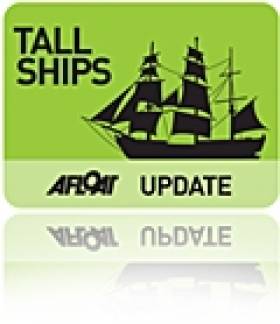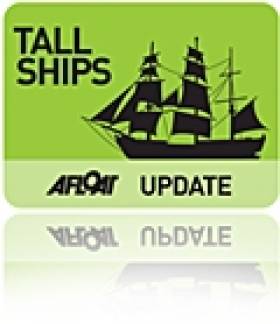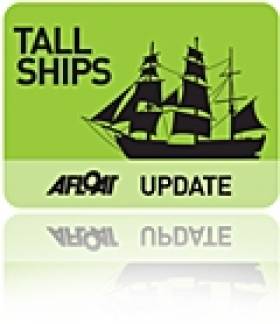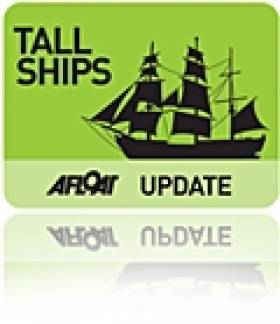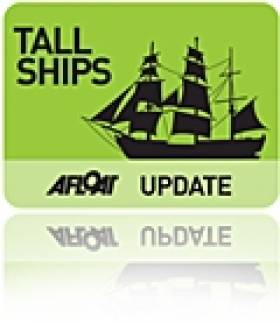Displaying items by tag: Tall Ships Races
Dublin Backed Out of Tall Ships Races Bid Over Costs
#TallShips - Dublin backed out of its bid to host the 2019 Tall Ships Races after Dublin City Council deemed the €3 million costs too high.
As the Irish Independent reports, the council said in defending the decision that the cost "represents a very significant funding implication for DCC", describing it as bigger than its annual budget for festivals and events throughout the year – including the now annual Riverfest.
Business leaders described the move as "disappointing" in light of the expected €30 to €75 million boost to the local economy from an event that attracted over a million visitors when it was last staged in the capital in 2012.
As previously reported, Galway is already stepping into the breach by mounting its own bid to host the tall ships in the same harbour that welcomed the Volvo Ocean Race in 2012 and 2009.
The Irish Independent has more on the story HERE.
Watch the Tall Ships Leaving Dublin Bay
#TALL SHIPS - TheJournal.ie this week highlighted this wonderful video of the Tall Ships Races fleet as they departed Dublin Bay on Sunday 26 August.
Filmmaker Rachel O'Connor captured this footage on board the racing sloop Sceolaing along with its owners the Delaps.
"Nearly everyone who had a boat was out at sea," says O'Connor. "The spectacle was breathtaking."
Judging by the sights she captured here, we're inclined to agree!
Tall Ships Conference to Address Needs of Vessel Operators
#Tallships – The event organisers and charity behind The Tall Ships Races, Sail Training International, is hosting the only conference this year to address all of the needs of vessel operators, sail training programme providers and host ports. It is taking place in Riga next month. Two new events will also be officially launched at the conference.
In August the Tall Ships visited Dublin in the major maritime event of the year for Ireland and last year the Tall Ships Race visited Waterford drawing massive crowds on both occassions.
Over fifteen seminars and workshops, over two days, will provide tailored programmes to meet the needs and interests of vessel operators, sail training programme providers, ports hosting sail training events and anyonewith an interest in sail training and Tall Ships races and regattas.
The conference is being held at the Radisson Blu Hotel Latvija, located in the heart of Riga, the historic capital of Latvia (a UNESCO World Heritage Site), Friday 16 - Saturday 17 November.
Peter Cardy, Chief Executive of Sail Training International, conference organiser, said, "This is the only global conference for sail training and the perfect opportunity for sail training fans from around the world to gather,network and share ideas. We've packed this year's conference full of practical advice and support - from how to recruit and motivate trainees and volunteers; event planning and economic impact studies, to sponsorship ideas and a chance to talk to experts.
"'For vessel operators there are major sessions on exploring the dynamics of extreme weather, looking at Tall Ship stability and exploring approaches to vessel safety and incidents.
"We'll be offering help on brand and marketing; exploring the importance of partnership working for our media relations and looking at some cutting edge ideas for developing social marketing.
"There will also be feedback from this year's Tall Ships Races and events and lots of opportunities to share knowledge and ask questions."
An event highlight is the Gala Dinner (included with the conference ticket) and the official launch of two exciting new races in the Tall Ship calendar:
The Mediterranean Tall Ships Regatta, 21 September – 7 October 2013 (Barcelona, Spain – Toulon, France – La Spezia, Italy)
The Black Sea Tall Ships Regatta, 30 April – 28 May 2014 (Varna, Bulgaria - Novorossiysk, Russia -Sochi, Russia - Constanta, Russia)
Book your place at the conference here
Time for a New Tall Ship for Ireland in 'Ocean Wealth' Plan
#TALL SHIPS - The chairman of the group that brought the Volvo Ocean Race to Galway this summer has urged Ireland's maritime interests to take stock as the Tall Ships Races Festival takes over Dublin this weekend.
In a letter to The Irish Times yesterday, Let's Do It Global/Ocean Youth chair Enda O'Coineen said there is an opportunity within the new Integrated Marine Plan to build a new cross-border national flagship to replace the Asgard II and promote youth sail training as a platform for "education and character development for young people" in Ireland.
O'Coineen writes that it is "critical, as islanders, to realise that we are becoming just spectators, withdrawing from the ocean, instead of educating our youth to embrace it and its wealth."
As previously reported on Afloat.ie, the new 'ocean wealth roadmap' is specifically geared towards exploiting the potential for 'blue growth' in the Irish economy.
An informal event will be held at A&L Goodbody in the IFSC tomorrow morning amid the Tall Ships Races festivities to discuss plans for a new flagship for Ireland, which have been in the works since last year.
The draft plan has had input from a broad range of stakeholders in youth, tourism, ports, construction, the Naval Service and nautical colleges, the coastguard and the diaspora. And O'Coineen adds that opinions and input will be needed and appreciates, especially in how the proposals can integrate with the new Marine Plan.
Howth Yacht Club to Officiate Tall Ships Send-Off on Sunday
#TALL SHIPS - Howth Yacht Club has announced that its vessels and race management teams have been asked to provide the official send-off for the Tall Ships Races fleet, which will take place in the centre of Dublin Bay at 6pm this Sunday.
HYC's members will be making a beeline for the bay after the completion of this weekend's Puppeteer National Championships in Howth - not to mention the spectcle of the Parade of Sail which kicks off at 1pm. HYC suggests the Howth Head cliff path between the summit and Redrock as a prime spot to watch the tall ships depart.
The club also urges members who wish to sail to the Liffey to see the Tall Ships Races fleet tomorrow to observe Dublin Port's notice to mariners for the festival.
Sightseeing craft will only be allowed past the Eastlink bridge for no more than 30 minutes at 10am, 12pm, 3pm and 7pm and may only navigate the Liffey as far as the Samuel Beckett Bridge. Extra toll bridge opening times may be added as demand dictates.
Dedicated escorting craft will be on hand to ensure a smooth procession. Sightseeing craft will not be allowed to go alongside the berths or vessels in the Tall Ships fleet, and no personal water craft such as Jet Skis or kayaks will be permitted.
Full details are included in the Dublin Port Company Notice to Mariners No 16 of 2012.
Step Aboard the Tall Ships in Dublin This Weekend
#TALL SHIPS - Organisers of the Tall Ships Races Festival - which kicks off today in Dublin's Docklands - have announced visiting hours for members of the public to step on board some of the 43 vessels docked on the city's quays between now and Sunday.
A total of nine tall ships will have free access to the public at different times over the weekend, available on a first come first served basis.
On the south quays, the Amerigo Vespucci will be open today from 3pm to 7pm, tomorrow from 10.30am to 1pm and 3pm to 6pm, and Saturday from 10.30am to 1pm and 3pm to 7pm.
The Mexican tall ship Cuauhtemoc - the last of the fleet to arrive this morning - will be open till 7pm today, and from 10am till 11pm tomorrow and Saturday.
The Danmark has open hours today from 3.30pm to 5pm, from 1.30pm to 5pm tomorrow and on Saturday from 1pm to 4pm.
The Guayus stays open to the public today till 9pm this evening, and will be open again tomorrow and Saturday from 10am till 9pm, and on Sunday before the Parade of Sail from 10.30am to 1pm.
The Lord Nelson will be open on Saturday from 10am to 1pm and 2pm to 5pm, while the Pelican of London is open tomorrow and Saturday from 10am to 1pm and 3pm to 6pm, and on Sunday morning from 10.30am till 1pm.
Completing the south quays moorings, the Stavros S Niarchos will be open tomorrow from noon till 5pm and on Saturday from noon till 6pm.
On the north quays, the Fryderyk Chopin is open till 1pm today and again from 3pm to 6pm. It reopens tomorrow and Saturday from 10am till 1pm, and on Sunday from 10.30am to 1pm.
And the STS flagship Pogoria will welcome the public tomorrow from 10am to 6pm and again on Saturday from 10am till 2pm.
Meanwhile, don't forget that another great way to see the tall ships at their moorings is from the water on board the Allianz All-Aboard Liffey Cruise, with seats available from just €1!
Teen Rescued from Docklands During Tall Ships Festival Prep
#TALL SHIPS - A 15-year-old boy was rescued from the water at Dublin's Grand Canal Dock yesterday after getting into difficulty while swimming.
According to RTÉ News, the teenager from Blanchardstown was swimming with a number of friends at Hanover Quay amid preparations for the Tall Ships Races Festival when he went missing around lunchtime yesterday.
Fire officers reportedly retrieved the boy from the water and gave him CPR on the quayside before he was transferred to St Vincent's Hospital in Merrion.
The Irish Times reports that the teen was in the area to volunteer with the Kings of Concrete urban sports display group as part of the Tall Ships Races events.
Organisers later confirmed that the boy was not preparing for his volunteer work at the time of the incident, which underlines the importance of water safety for all volunteers and visitors at the Docklands festival starting tomorrow.
Safety is also paramount aboard the tall ships fleet as they make their way to the capital, with damage inflicted on nearly all the more than 40 vessels in stormy conditions in the Bay of Biscay, according to the Irish Independent.
Ecuadorian naval ship the Guayas suffered eight ripped sails in the storm, but the worst damage was sustained by the Polish schooner Captain Borchardt, which arrived in Dublin with a broken mast.
However, master of the skip Janus Zbierajewski jokingly described the experience as "absolutely perfect weather".
The bad weather was enough to force at least once ship to abandon the final race leg, with Sail Training Association flagship STS Pogoria arriving in Dublin Port some days ahead of schedule.
Tall Ships Dublin Organisers Launch Festival Programme
#TALL SHIPS - Preparations are well underway for the arrival of the Tall Ships Races Festival Dublin, one of the most anticipated events of the year which kicks off this Thursday 23 August.
Presented by the Polish port city of Szczecin and organised by Sail Training International, the festival in Dublin's Docklands aims to top last year's celebrations in Waterford and will see the city come alive with a spectacular atmosphere both on and off the water.
Some of the 40 magnificent Tall Ships - such as the barque STS Pogoria – have already begun to arrive in Dublin Port at the end of the prestigious international race and will line the North and South of the River Liffey as the centerpiece of the four-day free festival.
Along with Waterways Ireland's programme at Grand Canal Dock as previously reported on Afloat.ie, organisers Dublin City Council and the Dublin Port Company have scheduled an impressive series of events to herald the arrival of the fleet that will cater for all tastes and ages and will showcase Dublin at its very best.
And don't forget you can catch all the sights on the Allianz All-Aboard Liffey Cruise, with seats available for just €1!
The highlight of the weekend is bound to be the stunning Parade of Sail as the ships depart the capital on Sunday 26 August from 11am.
Friday afternoon will also see thousands of Tall Ships crew members from all four corners of the globe march up Dublin’s north quays from Point Village for what promises to be a vibrant, colourful spectacle to kick off the weekend, finishing at The Custom House for a special prize giving ceremony with musical accompaniment from the the Garda Band, the Tallaght Youth Band and the Army No 1 Band.
Also taking place is a series of maritime-themed readings and talks in various locations, including a barge, which will celebrate the history and some of the personal tales from Dublin’s Docklands.
Celebrated writers and historians such as Peter Sheridan, Theo Dorgan, Anne Chambers, Turtle Bunbury and the local Dockers Preservation Society will regale their audiences with tales of Dublin City, its port, their sailing experiences, excerpts from their books. See www.dublintallships.ie for times and e-mail your name and title of talk to [email protected] to be placed on the guest list - first come, first served.
Complementing the maritime element, the festival will feature 55 music acts over the four days including the Undertones, Ash and Therapy? at the Bulmers Live Music Dock at George’s Dock. And the entertainment continues into the evening with an open-air floating cinema showing classics such as Jaws and The Life Aquatic.
More than 100 performance acts from trapeze artists to wake boarding will wow the crowds on both sides of the river each afternoon, not to mention food and craft markets, walking literary tours and a funfair.
On the south quays, Grand Canal Dock will host a family zone, while Hanover Quay will come alive with skateboarding, parkour, beatboxing and music with the spectacular Kings of Concrete. Visitors can also try their hand at cable kayaking, pedalo boats, wakeboarding and crazy golf on a pontoon at Grand Canal Dock with Waterways Ireland and Surf Dock.
On the other side, food demonstrations from some of Ireland’s leading chefs will take place at the Theatre of Food in Linear Park. And the Festival Hub at CHQ will have a more relaxed atmosphere with a beautiful black and white photography exhibition from the Dublin Docklands Preservation Society, a range of workshops including yoga and 'upcycling' an and exhibition of Viking Dublin in the vaults.
Full details of events and how to get to the Tall Ships Races Festival can be found at www.dublintallships.ie. Gardaí are appealing for visitors to use public transport into the city due to a number of road closures, and have warned that anti-social behaviour including pubic drinking will not be tolerated.
#TALL SHIPS - Waterways Ireland has announced a series of events around Grand Canal Dock in support of the Tall Ships Races Festival.
The events will be centred around the Waterways Ireland Visitor Centre on Grand Canal Quay, with a full programme of children’s art and craft workshops and two exhibitions running throughout the festival. The programme includes:
'A Very Grand Canal' Art Exhibition
A Very Grand Canal is a collection of artistic responses to the Grand Canal commissioned by Offaly County Council through the Per Cent for Art scheme. Three projects were chosen, some with multiple outcomes, all illuminating the Grand Canal in ways not seen, heard or read before. The artists include, Geraldine O’Reilly (printmaker), La Cosa Preziosa (sound artist), Martina McGlynn and Garret Daly (Filmmakers), Eugene O’Brien (writer) Veronica Nicholson (photographer) and Wayne Brennan (musician). The exhibition runs throughout the Tall Ships festival from 10am to 6pm daily.
Small Ships at the Tall Ships
Small Ships at the Tall Ships is an exhibition of work by the Irish Model Boat Club, featuring small tall ships, RNLI lifeboats and a 16ft model of the Titanic. There will also be a demonstration of radio controlled model boats, and a model boat building workshop for children 7 and up (call 01 677 7510 to book; places are limited). The exhibition is open daily throughout the festival.
Waterways Ireland Community Choir
The Waterways Ireland Community Choir’s members are local people from the Docklands and along the canals coming together to sing songs of the rivers, canals and docks. Their performance on the jetty of the Waterways Ireland Visitor Centre at 4pm on Saturday 25 August will feature a wide repertoire of songs including Simon & Garfunkel’s 'Bridge Over Troubled Water' and the more light-hearted traditional song 'Drunken Sailor'.
'Decorate Your Duck' Workshop
Who will have the best looking duck in the Duck Race? The Decorate Your Duck workshop runs in the Waterways Ireland Visitor Centre on Saturday and Sunday from 11am to 3pm. There will be glitter and glue, paint and polish, so come on down and give your duck some character! The Duck Race is run in aid of St Andrews Resource Centre, Pearse Street.
'Watery Stories' with Púca Puppets
Niamh from Púca Puppets invites the young (and young at heart) to meet 'canalmaid' Mary Mary, who will pull ashore at the Waterways Ireland Visitors Centre for the Dublin Tall Ships Festival and is looking for help in finding clues, creating and drawing stories to illustrate life on and in Ireland's canals and inland waterways. Suitable for 6-10 year olds and their families, Watery Stories takes place on Friday 24, Saturday 25 and Sunday 26 August at 11am and 2pm. Booking is advisable as places are limited - phone 01 677 7510.
Volunteers Wanted for Dublin Tall Ships Festival Info Stand
#TALL SHIPS - Sail Training Ireland is seeking more volunteers to help out at the Tall Ships Races Festival information stand from next Thursday 23 to Sunday 25 August.
Michael Byrne of Sail Training Ireland for Youth Development says organisers need enthusiastic people that have an interest in sail training who are willing to spend a half day on the stand on Thursday afternoon from 4pm to 9pm or on Friday from 10am to 9pm.
The stand is located at the entrance to the Naval Service vessel LE Emer and will be a great location to get a feel for the festival.
It's also hoped that some of the trainees arriving on the ships will "bring some exciting tales to share of their crossing of the Bay of Biscay", says Byrne.
If you are interested, please call Michael Byrne at 01 887 6046 (office) 086 034 6038 (mobile) or send an email to [email protected] with your name and phone number and times of interest.



























